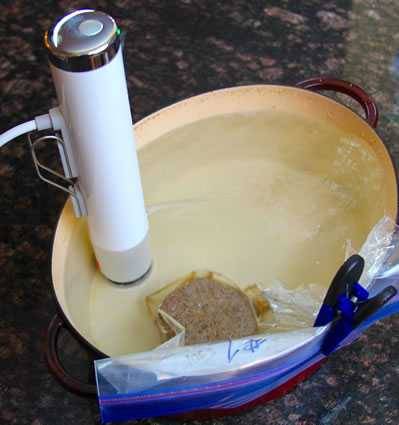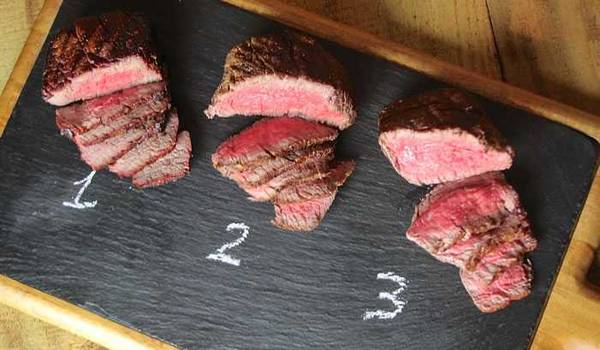As a hard core griller, I often lie awake at night dreaming of the perfect steak, an intoxicating mouthful of flavor with every bite. Tender as a love ballad, juicy as a Georgia peach, with a crisp crust that deftly balances smoke and seasoning to create a steak that puts even the finest steakhouse to shame.
That quest has led me to Sous-Vide-Que, combining sous vide and grill. Preparing food via a controlled temperature water bath is a fine technique that marries well with the grill and smoker (click here to read more about how sous vide works with grilling and barbecue). It is, in fact, a superb variation on a technique we have long promoted, called reverse sear (click here to learn more about the reverse sear technique).
When preparing a steak via sous vide, the meat is generally seasoned with salt and sometimes with the addition of olive oil, butter, and/or fresh herbs for added flavor, and then placed in an airtight plastic bag before being submerged in a hot water bath that has been set to a precise temperature. Depending on the cut of beef and its thickness, the process can take anywhere between 75 minutes and six hours according to “The Complete Sous Vide Cookbook” by Chris McDonald.

Once removed from the hot water bath, steaks are far from plate ready as they are the same unappealing gray color you would expect to see had they been steamed or boiled. So I then turn to live fire in order to bring a little more color, crust, and life to this listless piece of beef.
To see if there is a better way, I tried three different methods. For the first steak, I employed a popular restaurant technique: The steak is cooked in the hot water bath, moved to an ice bath comprised of an equal mix of ice and water until fully chilled, then smoked, then seared using the traditional reverse sear method. The second steak was cold smoked before being placed in a hot water bath for the same time period and seared. Normally we strongly advise against cold smoking meats (read more about it here), but sous vide at 131°F and above pasteurizes the meat, so there is no risk. The third steak was done the normal way, hot water bath and finishing sear. A fourth method, in which the steak is seared then sous vide, was not included as the water bath softens that perfect crust we all prefer when eating a good steak.
Explore the world of Sous Vide Que, the ultimate marriage of water and smoke, by clicking here to download our ebook “Sous Vide Que Made Easy” for $3.99 on Amazon (free Kindle app runs on all computers). Or get the book and others FREE as a member of the AmazingRibs.com Pitmaster Club. Click here to join.
For the test, I used three filets mignon, each weighing seven ounces. Steaks were seasoned with a simple blend of Kosher salt and ground black pepper with no additional oils, fats, herbs, or other flavor enhancers added to the sous vide bag. Each steak was cooked for 1 1/2 hours in a water bath that had been set at 131°F for medium-rare with a Joule. The searing and smoking was done with a good old Weber Kettle.
Steak #1: Sous vide, then chill, then smoke, then sear
The steak was seasoned, sealed in a bag, and cooked in a water bath for 1 1/2 hours. The steak was then placed in the refrigerator to fully chill before finishing on the grill. Once ready, the grill was prepared for 2-zone cooking, placing a chimney full of pre-heated charcoal briquets to one side of the grill’s charcoal grate in order to create direct and an indirect cooking zones. A handful of wood chips were also added to the charcoal for maximum smoke flavor. Once the grill was ready, the chilled steak was placed on the cooler side of the grill as far away from the heat source as possible. The lid was added (with the top vent fully opened and positioned directly above the steak in order to force the smoke over and around the meat) and the steak was allowed to smoke until it reached an internal temperature of 115°F. A remote thermometer such as the Thermoworks Smoke allows you to set and monitor the internal temperature while attending to other matters such as side dishes. The lid was then removed to maximize the grill’s temperature (approximately 550 to 600°F) and the steak was quickly seared on the direct heat side until a nice crust had formed (approximately 2 minutes per side).
Steak #2: Cold smoke, then sous vide, then sear
For the second steak, smoke was introduced at the beginning of the cooking process by cold smoking it. To create the cold smoking environment, three charcoal briquets were pre-heated, placed on one side of the grill’s charcoal grate, and topped with a handful of the same type of wood chips that were used for steak number one. Once seasoned, the steak was placed on the grill’s main cooking grate as far from the briquets as possible. The lid was then placed on the grill with the top vent fully opened and positioned directly above the steak in order to force the smoke over and around the meat. After 20 minutes, the steak was removed from the grill, placed in a plastic bag, and cooked in a heated water bath for 1 1/2 hours. To finish the steak, it was removed from the bag and quickly seared on the grill at 550 to 600°F until a nice crust had formed (approximately 2 minutes per side).
Steak #3: Sous vide, then sear
The steak was seasoned, sealed in a bag, and cooked in a water bath for 1 1/2 hours, removed from the bag, and quickly seared on the grill at 550 to 600°F until a nice crust had formed (approximately 2 minutes per side).
The results: The perfect Sous-Vide-Que steak
All three steaks were completed simultaneously then sliced and served blind to a panel of five.
Four of the five, including Yours Truly rated Steak #1, sous vide, chill, smoke, then sear as their favorite, followed by Steak #2, the cold smoke, sous vide, sear steak, and, in last place, Steak #3, the sous vide, sear steak. According to these tasters, while the cold smoked steak had more of the “grilled flavor” they were looking for when compared to the more simply prepared steak number three, the first steak not only had a deeper smoky taste but also a more uniformly finished crust thanks to the reverse sear. It is also worth noting that while some found the third steak to be somewhat more tender, the difference was negligible and could be the result of a slight differential in the finished temperature of the three steaks. The fifth taster ranked them Steak #2, #1, and #3.
So in the end, the winner of the battle for the best Sous-Vide-Que steak goes to the one that combines our favorite steak grilling technique – the reverse sear – with the magic of sous vide. While the process of sous vide, chill, smoke, and reverse sear is time consuming, the end product will be one of the best steaks you’ve ever created. And there is the added benefit: Steaks can be sous vide and chilled up to two days in advance, thereby speeding up the cooking process when you are ready to feed the hungry masses.
The Big Chill: How it works
So why employ the chilling technique and how does it help in creating such a memorable steak? Rapidly chilling sous vide foods has long been a popular technique among chefs who want the benefits of a low and slow, controlled temperature water bath but also the flexibility to finish dishes rapidly as orders are placed.
In order to properly, and safely, execute the method, food is prepared in a sous vide bath then quickly immersed in a 50/50 mix of water and ice in order to rapidly reduce the core temperature of the food to a safe range of 34-38°F. Once food has remained in the ice bath for at least 30 minutes, it can be refrigerated or frozen.
For the home cook, the cook-chill-smoke-grill method can be a great time saver as food can be prepared via the sous vide then refrigerated for several hours or up to two days until ready to finish on the grill for family or guests.
But beyond the convenience factor, rapidly chilling sous vide foods may have an additional benefit according to AmazingRibs.com Science Advisor Prof. Greg Blonder.
While far from conclusive, Blonder notes that “First, as the meat is reheated, the pH will begin to rise thereby enhancing tenderizing enzymatic activity [enzymes are inhibited by low pH or acidity]. Second, tenderizing enzymes like calpain are always paired with inhibitory proteins like calpastatin, In the live animal these two are part of a regulatory cycle that keeps muscles healthy and sweeps out dead cells. Their levels are maintained in balance. When the animal dies, although no new enzymes are produced, they remain active. As you raise the temperature via the controlled water bath, enzymes increase in activity and more are released from damaged cells.
“It is possible that the antagonist calpastatin degrades more easily than calpain, leaving more calpain available to tenderize the muscle. So when you sous vide you break apart muscle because calpain is more active, and when you cool the meat it still keeps working because the inhibitory protein has been used up.”
Regardless of its exact impact on the final product, the cook-chill-grill method is one that will certainly have an important place in the evolution and growth of Sous-Vide-Que.



High quality websites are expensive to run. If you help us, we’ll pay you back bigtime with an ad-free experience and a lot of freebies!
Millions come to AmazingRibs.com every month for high quality tested recipes, tips on technique, science, mythbusting, product reviews, and inspiration. But it is expensive to run a website with more than 2,000 pages and we don’t have a big corporate partner to subsidize us.
Our most important source of sustenance is people who join our Pitmaster Club. But please don’t think of it as a donation. Members get MANY great benefits. We block all third-party ads, we give members free ebooks, magazines, interviews, webinars, more recipes, a monthly sweepstakes with prizes worth up to $2,000, discounts on products, and best of all a community of like-minded cooks free of flame wars. Click below to see all the benefits, take a free 30 day trial, and help keep this site alive.
Post comments and questions below
1) Please try the search box at the top of every page before you ask for help.
2) Try to post your question to the appropriate page.
3) Tell us everything we need to know to help such as the type of cooker and thermometer. Dial thermometers are often off by as much as 50°F so if you are not using a good digital thermometer we probably can’t help you with time and temp questions. Please read this article about thermometers.
4) If you are a member of the Pitmaster Club, your comments login is probably different.
5) Posts with links in them may not appear immediately.
Moderators